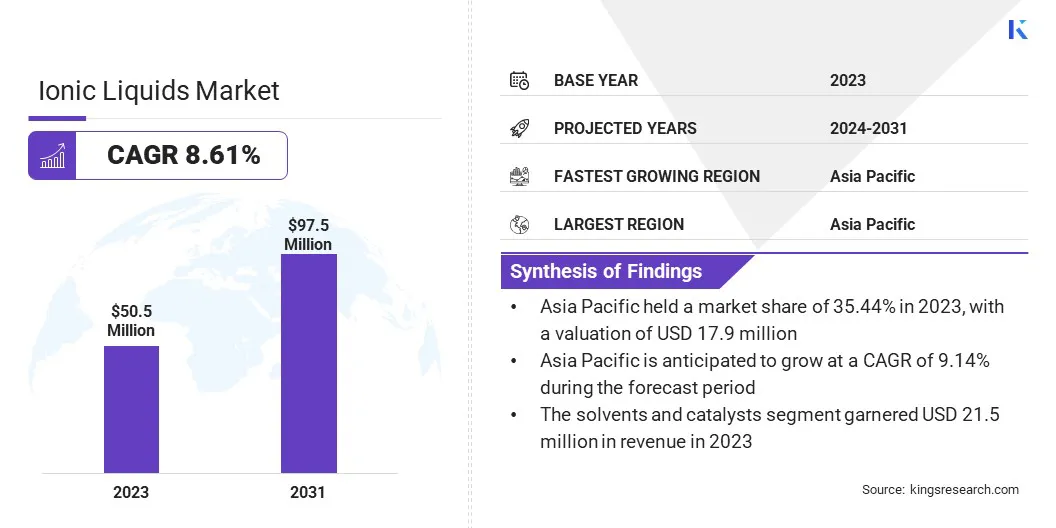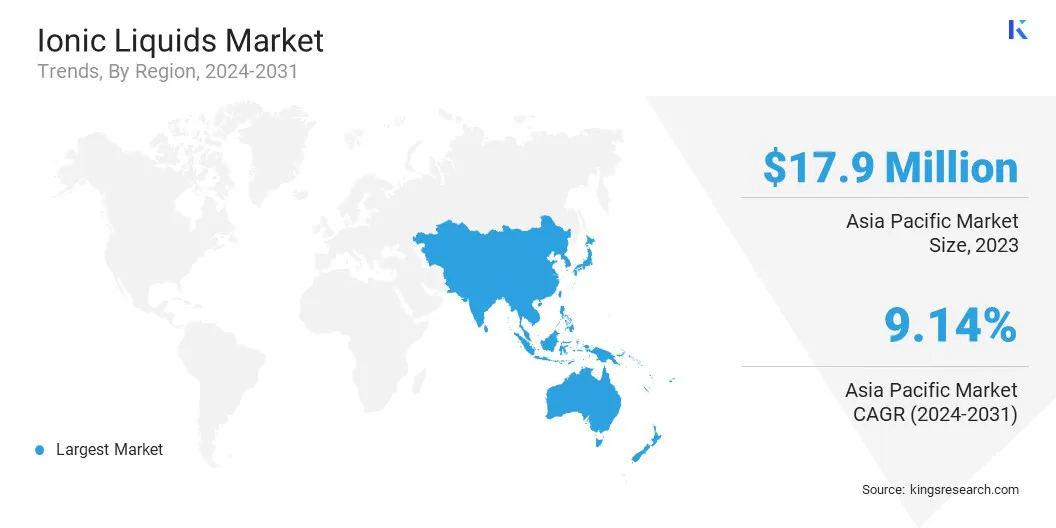Ionic Liquids Market Size
The global Ionic Liquids Market size was valued at USD 50.5 million in 2023 and is projected to grow from USD 54.7 million in 2024 to USD 97.5 million by 2031, exhibiting a CAGR of 8.61% during the forecast period.
The rising emphasis on sustainability and environmentally friendly practices in industries is boosting the adoption of ionic liquids as alternatives to volatile organic solvents. Their negligible vapor pressure and non-flammability make them ideal for green chemistry applications.
In the scope of work, the report includes products offered by companies such as BASF, Arkema, Tokyo Chemical Industry, Merck KGaA, SOLVIONIC, Solvay S.A, Reinste Nano Ventures, KOEI CHEMICAL CO., LTD., Iolitec Ionic Liquids Technologies GmbH, Chevron Corporation, and others.
Moreover, Ionic liquids are increasingly used in lithium-ion battery production for their superior thermal stability and efficiency as electrolytes. These properties address key challenges in battery safety and performance, particularly in high-temperature environments. They extend battery lifespan and energy density, meeting the rising demand for electric vehicles and portable electronics.
Ionic liquids are a class of compounds made entirely of ions,comrising an organic cation and an inorganic or organic anion. Unlike traditional salts, they remain liquid at relatively low temperatures, often below 100°C.
These liquids are characterized by their unique physicochemical properties, including low volatility, high thermal stability, tunable viscosity, and excellent ionic conductivity. Ionic liquids are highly versatile and find applications in green chemistry, energy storage, catalysis, and material science.
Their role as eco-friendly solvents, enhancers of efficient chemical reactions, and supporters of advanced technologies has made them integral to modern industrial and scientific advancements.

Analyst’s Review
The growing demand for renewable energy technologies, including batteries and fuel cells, is bolstering the growth of the ionic liquids market. Their high ionic conductivity and exceptional stability under extreme conditions make them crucial for enhancing the performance and efficiency of energy storage systems.
Particularly in electric vehicles (EVs) and grid storage solutions, ionic liquids are enabling longer-lasting and more reliable energy storage, which is essential to meet the rising demand for sustainable energy solutions.
- In February 2024, the World Resources Institute reported that 2023 set a record for clean energy deployment in the U.S. This achievement is marked by a significant increase in solar and energy storage installations, rising electric vehicle (EV) sales, and a growing number of planned domestic manufacturing facilities.
The global shift toward clean and renewable energy is propelling the growth of the ionic liquids market, particularly in energy storage technologies. This trend reflects the industry's commitment to improving energy efficiency, reducing carbon emissions, and meeting global sustainability targets.
Ionic Liquids Market Growth Factors
The exceptional water solubility and ionic conductivity make them highly suitable for advanced energy technologies, including batteries, fuel cells, and electric motors. These properties enhance the efficiency and performance of energy storage and conversion systems, meeting the growing demand for reliable and sustainable energy solutions.
The increasing adoption of electric vehicles and renewable energy systems is further boosting the demand for ionic liquids in these innovative technologies.
- In June 2024, research published by Tsinghua University Press highlighted the significance of integrating a polymerized ionic liquid with metal halide perovskite to improve the performance of solar cells
Moreover, Ionic liquids have emerged as a preferred choice for carbon capture systems due to their ability to selectively absorb and release CO₂ under controlled conditions. Their application is expanding in industries seeking sustainable solutions to meet stringent environmental regulations on greenhouse gas emissions.
These liquids offer higher efficiency and lower energy consumption than traditional amine-based solvents, making them cost-effective for large-scale carbon sequestration projects. The growing focus on net-zero emissions and the adoption of cleaner industrial processes are further increasing the demand for ionic liquids in environmental applications.
However, the complex production processes required and the need for specialized raw materials make iconic liquids relatively expensive than traditional solvents, hindering market growth. This presents a challenge for industries seeking cost-effective solutions.
However, ongoing research into efficient and sustainable production methods, such as the development of green synthesis routes and the optimization of raw material sourcing, holds the potential to lower costs. Overcoming this challenge could significantly boost adoption and market expansion in the near future.
Ionic Liquids Market Trends
Ionic liquids are increasingly used in biopharmaceutical applications for their ability to stabilize enzymes and proteins under extreme conditions. Their tunable properties allow precise optimization for drug development and bio-reaction environments, enhancing production yields and reducing costs.
Pharmaceutical companies are leveraging ionic liquids to improve the solubility and bioavailability of active pharmaceutical ingredients. The surgincreased demand for biologics has enhanced the role of ionic liquids in fostering innovation in the pharmaceutical sector, thereby fueling the growth of the ionic liquids market.
Additionally, ionic liquids are increasingly used in additive manufacturing to enhance the properties of 3D printing materials, particularly resins and polymers. Their unique ability to improve the precision, flexibility, and mechanical strength of printed products is fostering adoption in industries that require high-performance materials such as aerospace, automotive, and healthcare.
The tunable properties of ionic liquids allow for the creation of customized materials for specific applications. The adoption of 3D printinting technologies is increasing driven by the growing demand for advanced, sustainable solutions, and the integration of ionic liquids presents significant opportunities for innovation, efficiency, and sustainability in manufacturing processes.
Segmentation Analysis
The global market has been segmented based on application and geography.
By Application
Based on application, the ionic liquids market has segmented into solvents & catalysts, extractions & separations, bio-refineries, energy storage, and others. The bio-refineries segment is poised to witness significant growth, recording a robust CAGR of 9.35% through the forecast period.
Ionic liquids are used in bio-refineries to improve biomass processing, facilitating the conversion of raw materials into biofuels and other bio-based chemicals. Their low volatility, tunable properties, and ability to dissolve complex organic molecules make them ideal for facilitating chemical reactions in biomass processing.
With the growing emphasis on green chemistry and sustainable industrial practices, bio-refineries are increasingly adopting ionic liquids to reduce environmental impact, improve process efficiency, and promote renewable energy solutions, thus fostering segmental growth.
Ionic Liquids Market Regional Analysis
Based on region, the global market has been classified into North America, Europe, Asia-Pacific, MEA, and Latin America.

Asia Pacific ionic liquids market accounted for a substantial share of around 35.44% in 2023, with a valuation of USD 17.9 million. Asian countries are prioritizing industrial upgrading to enhance the integration of advanced technologies into their manufacturing processes, which is stimulating regional market expansion.
Strategic incentives and government grants have been pivotal in driving industrial transformation, creating a favorable environment for the growth of advanced materials such as ionic liquids, which are integral to the development of cutting-edge manufacturing technologies.
Moreover, Asia-Pacific is at the forefront of electronics and semiconductor manufacturing, with ionic liquids increasingly used for their high thermal stability and electrical conductivity. These properties make them ideal for applications in electronics cooling, semiconductors, and advanced manufacturing processes.
The expanding electronics market in China, South Korea, and Taiwan is increasing the demand for ionic liquids, which enhance the performance and efficiency of electronic components.
- The Asian Development Bank report highlights that East and Southeast Asia produced over 80% of global semiconductors in 2023, playing a pivotal role in advancing artificial intelligence and fueling global technological growth.
Europe ionic liquids market is set to experience significant growth, registering a robust CAGR of 9.01% over the forecast period. Europe’s commitment to clean energy and reducing carbon emissions is leading to the increased demand for ionic liquids in energy storage and renewable energy applications.
The growing adoption of electric vehicles (EVs) and the expansion of renewable energy infrastructure in Germany, France, and the UK are further fueling the demand for ionic liquids in these applications.
- The updated Renewable Energy Directive raises the European Union's binding renewable energy target for 2030 to at least 42.5%, up from the previous 32%, with a goal of reaching 45%.
This revised target is expected to boost the adoption of advanced technologies, including ionic liquids, which are crucial for improving energy storage systems and supporting the expanding renewable energy infrastructure in the region.
Competitive Landscape
The global ionic liquids market report will provide valuable insight with an emphasis on the fragmented nature of the industry. Prominent players are focusing on several key business strategies such as partnerships, mergers and acquisitions, product innovations, and joint ventures to expand their product portfolio and increase their market shares across different regions.
Strategic initiatives, including investments in R&D activities, the establishment of new manufacturing facilities, and supply chain optimization, could create new opportunities for market growth.
List of Key Companies in Ionic Liquids Market
- BASF
- Arkema
- Tokyo Chemical Industry
- Merck KGaA
- SOLVIONIC
- Solvay S.A
- Reinste Nano Ventures
- KOEI CHEMICAL CO., LTD.
- Iolitec Ionic Liquids Technologies GmbH
- Chevron Corporation.
Key Industry Developments
- April 2024 (Acquisition): Arkema, a French specialty chemicals company, acquired a nearly 78% stake in Proionic, an Austrian start-up specializing in ionic liquid-based electrolytes for solid-state lithium-ion batteries.
The global ionic liquids market is segmented as:
By Application
- Solvents & Catalysts
- Extractions & Separations
- Bio-Refineries
- Energy Storage
- Others
By Region
- North America
- Europe
- France
- U.K.
- Spain
- Germany
- Italy
- Russia
- Rest of Europe
- Asia-Pacific
- China
- Japan
- India
- South Korea
- Rest of Asia-Pacific
- Middle East & Africa
- GCC
- North Africa
- South Africa
- Rest of Middle East & Africa
- Latin America
- Brazil
- Argentina
- Rest of Latin America


